1. Chinese sturgeon
The Chinese Sturgeon is a member of the Acipenseridae family of Acipenseriformes order, with the scientific name of
Acipenser sinensis. The local name for this species is Huang yu.
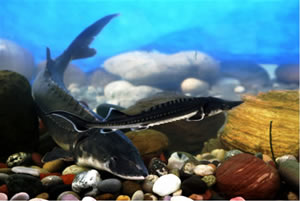 It is an animal strictly protected by the Chinese government, and is thought to have lived at the same time as dinosaurs, dating back to a period 140 million years ago. Because of that, it is sometimes also known as a living fossil. It can be considered a large fresh water fish, and is 200 to 500 centimeters in body length, with 200 to 500 kilograms in average weight. The largest one can weigh 550 kilograms. A grownup sturgeon measures up to 4 meters long, weighs over 1000 pound. Its head is acuminate, with the mouth under its jaw. Sturgeon is a comparatively inferior species of fish.
The Chinese Sturgeon has a habit of upstream migration, and dwells along the coasts of China's eastern areas and migrate into rivers for propagation upon reaching sexual maturity. Most aquatic animals are food for the young of the Chinese Sturgeon, while the adults feed on aquatic insects, larval, diatom and humic substances. Its reproductive capacity is poor; generally, it takes more than 10 years for Chinese Sturgeon to be sexually mature. The Chinese sturgeon is largely dispersed over the main streams of the Yangtze River and coastal regions of Qiantang River, Minjiang River and Pearl River. It is a precious, but endangered species native to China.The Chinese Sturgeon is of great academic interest in taxonomy and biology. The channel for adult fish migrating to superior spawning sites such as the Jinsha River in the upstream of Yangtze River was blocked after the construction of the hydropower project, Gezhouba Dam. For this reason, the government has invested huge labor power and financial resources to protect this precious species. At present, some success has been achieved with artificial inducement for spawning and stream discharge for incubation.
2. Chinese paddlefish
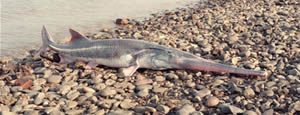 Paddlefish (Psephurus gladius)
English name : Chinese paddlefish. Endangered grades : Endangered. Chinese grade protection of wild animals. IUCN (1996) CR CITES (1997), Appendix II.
The Chinese paddlefish (Psephurus gladius) belongs to Acipenseriformes, Polyodontidae, Psephurus. It can grow up to 7 meters long and matured at 7-8 years. The species has been listed as a first class protected animal in China since 1989 and has also been on the Critically Endangered Species IUCN Red List since 2006. It distributes in the stem and some distributaries of Yangtze River and the estuary. It is believed that the fish spawns in March and April in the upper stream of Yangtze River, but the exact spawning locations have not been clear yet.
According to the incomplete census, during 1960-1980, the annual harvest of Chinese paddlefish was 75 tons. Due to the influence of human activities, the stock has been sharply declined since 1981. During 1981-2001, the incidental catches were 158 individuals in the reaches below Gezhouba dam and 44 individuals in the Yibin reaches of the Yangtze River.
There are two recent cases in saving the incidental catches of Chinese paddlefish. One is on Dec. 11, 2002 in Nanjing, a matured female was caught, which was 117kg in body weight, 330cm in total length, and estimated age of 15-20 years. She was get well day by day through our rescuing effort, but unfortunately, she died of a sudden in 29 days after captured. The other case was on Jan.25, 2003 in Yibin, a female with body length of 352cm was caught. After timely rescue, we returned her to Yangtze River, and tracked her for 50 hours by our ultrasonic tracking system but lost contact due to tracking boat crashed by a shoal. Even though, we still found that she could swim upstream, which means she was getting well.
Until now, None of Chinese paddlefish was caught and our team conducted broad-range hydroacoustic survey and capture tries in the lower Jinsha and the upper Yangtze rivers covering over 600 km river length during March to May between 2006 and 2011 for five times. The hydroacoustic signals indicated that these large fish likely survives in Yangtze River.
3. Dabry’s sturgeon
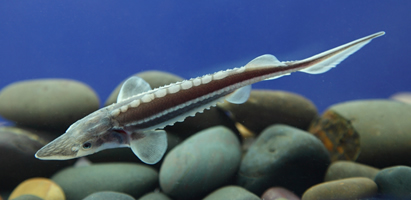 Dabry's Sturgeon (Acipenser dabryanus) , English name : River sturgeon, Dabry 's sturgeon. Rating : easy endangered crisis. Chinese grade protection of wild animals. IUCN (1996) CR CITES (1997), Appendix II.
Dabry’s sturgeon is a freshwater species that occurs only in the middle and upper reaches of the Yangtze River. It reaches at least 130 cm TL and 16kg BW.Major research was done from 1972 to 1975.This species is easily propagated ,and has excellent commercial aquaculture potential .The native population .however,sharplry declined in the last two decades .some fish still occur in the upper middle reach but few occurred in reaches below the Gezhouba Dam in recent years. 4. Chinese sucker
Rouge fish (Myxocyprinus asiaticus) is cypriniformes, English name: Chinese sucker. Rating : easy endangered crisis. Chinese grade protection of wild animals.
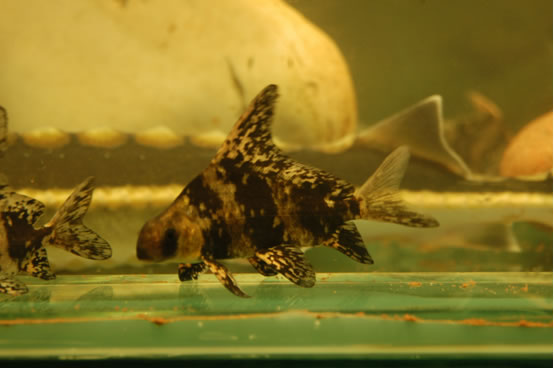 The Chinese sucker, Myxocyprinus asiaticus, is an endemic freshwater fish in China and the only representative of family Catostomidae in Asia. The fish is naturally distributed mainly in the Yangtze River, especially in the upper reaches. The wild fish source was greatly damaged due to over-harvesting and other human activities, to date the Chinese sucker has been an endangered species and has been listed in the second class of preserved animals in China. The Chinese sucker, Myxocyprinus asiaticus, is an endemic freshwater fish in China and the only representative of family Catostomidae in Asia. The fish is naturally distributed mainly in the Yangtze River, especially in the upper reaches. The wild fish source was greatly damaged due to over-harvesting and other human activities, to date the Chinese sucker has been an endangered species and has been listed in the second class of preserved animals in China.
5. Other species
Qinling lenok
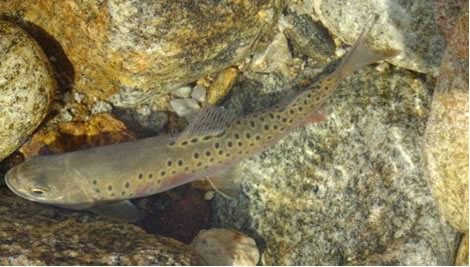 Qinling lenok(Brachymystax lenok tsinlingensis )is a residual species transferring from north to south during the ice age. It belongs to Brcahymystax, Salmonidae, Salmoniformes and is endemic to China. The fish is mainly distributed in the
upper reaches and tributaries of Weihe, and in the upper reaches of Xushuihe and Ziwuhe belonging to the tributaries on the north side of Hanshui. In 1988, B. l. tsinlingensis has been listed as wildlife under second class protection belonging to rare or near extinction species.
Hucho bleekeri
 Hucho bleekri is a residual species during the ice age,It belong to Hucho bleekri is a residual species during the ice age,It belong to
Salmonidae, Salmoniformes, Osteichthyes. The fish mainly distributed in Dadu river, Qingyi river ,the two are both
tributary of Min river, and Xiang river which is a tributary of Han river. Since 1988, Hucho bleekri has been listed as the
second class protected aquatic wildlife.
Gymnocypris przewalskii
 Gymnocypris przwalskii is the only economic migratory fish in Qinghai Lake, and is protected strictly in the Qinghai Lake ecosystem. G. przwalskii is the key species on the food chain of Qinghai Lake ecosystem, and played the irreplaceable
role on ecosystem balance and stability of Qinghai Lake ecosystem. Due to the over fishing and the habitats destruction, resulting in stock of G. przwalskii sharp decline, and the situation was extremely seriously at the mid-century. The stocks recovery measures of G. przwalskii has implemented from 80s of last century, and so far the socks of G. przwalskii has
been a marked increase. |








 Hucho bleekri
Hucho bleekri